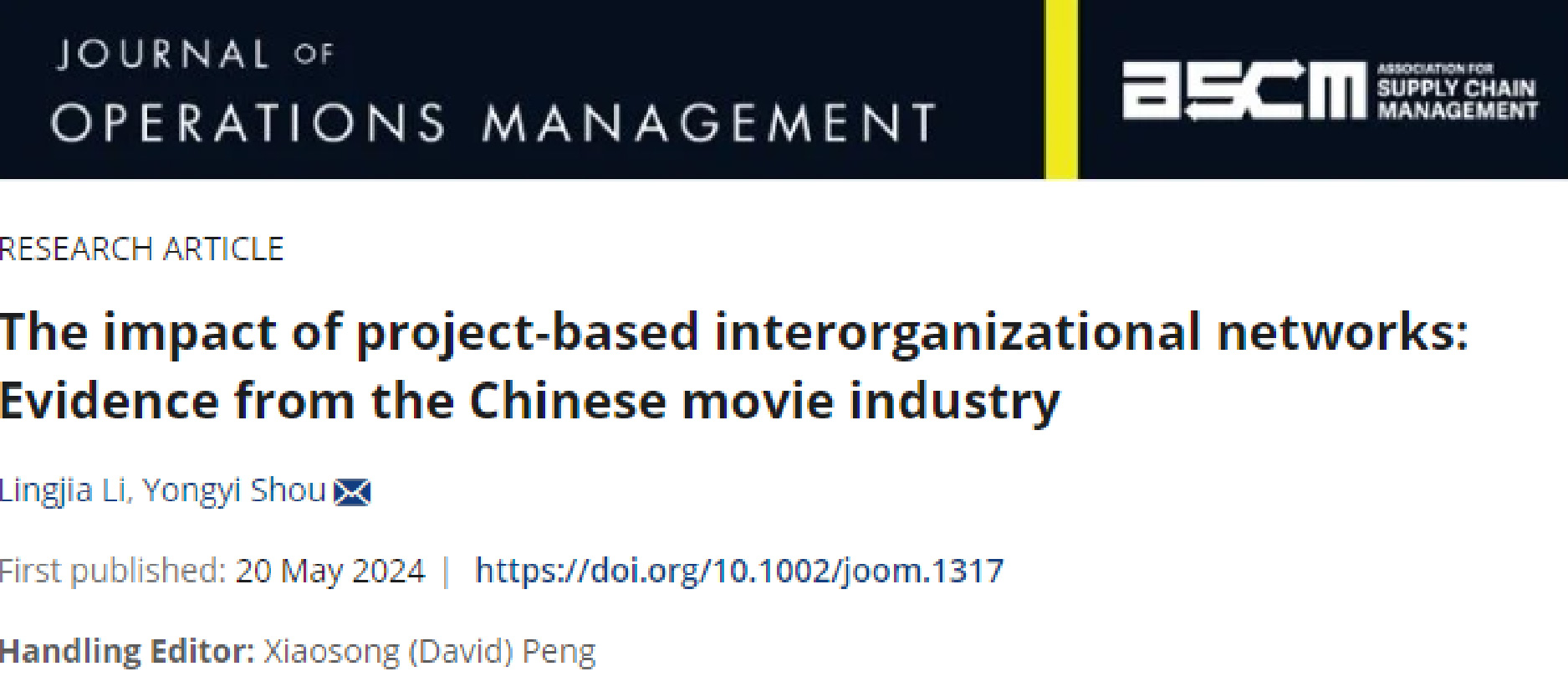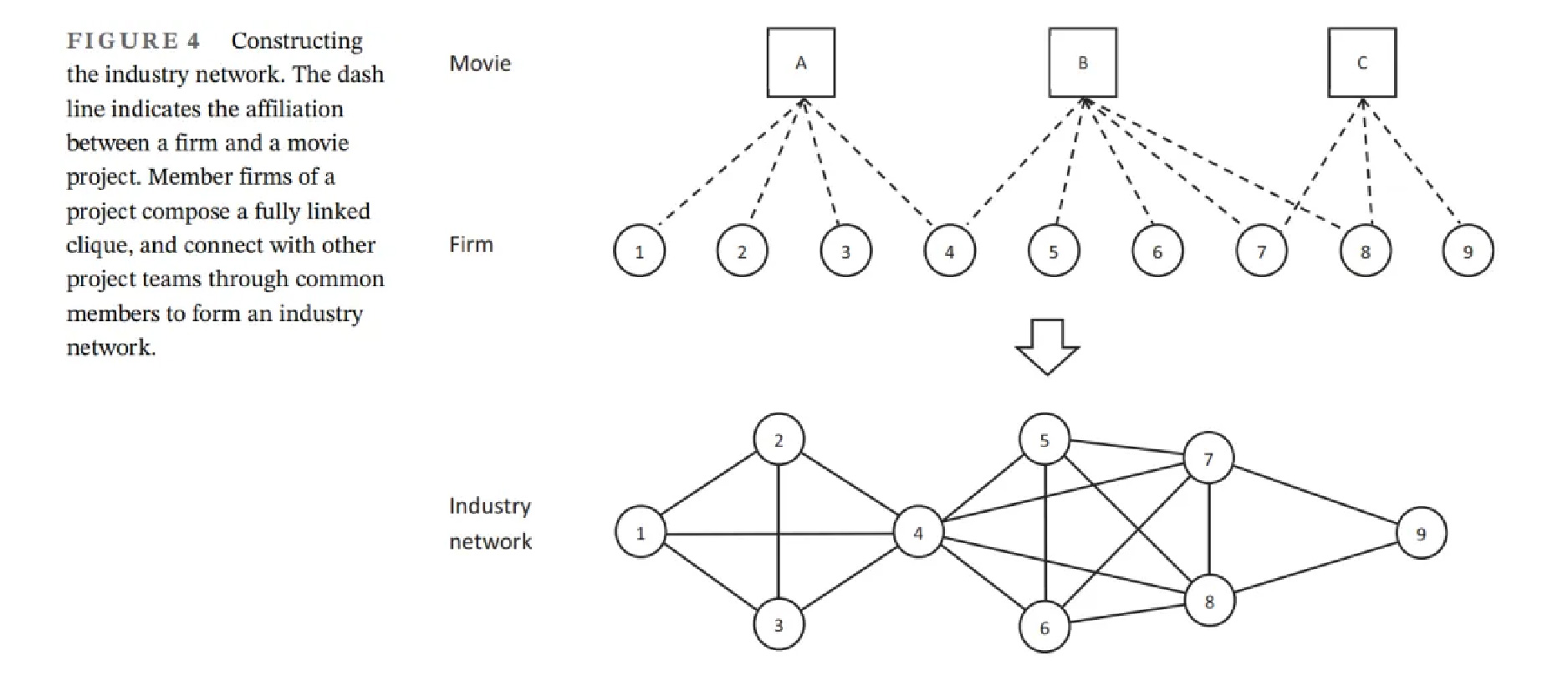
As a creative product, films are caught between commercial success (revenue) and artistic achievement (quality). Some films have good box office results but only average ratings, and some films have high quality but poor box office results.
Our ZJUSOM researchers have found that the collaborative status and strength of relationships between the film project team and other organizations such as producers, distributors, and cinemas directly influence the quality and sales of the movie.
Professor SHOU Yongyi from the Department of Service Science and Operations Management at Zhejiang University School of Management and doctoral student Li Lingjia published their research findings "The impact of project-based interorganizational networks: Evidence from the Chinese movie industry" in the international journal "Journal of Operations Management" (UTD24).

Click here to access the journal article
|
SHOU Yongyi | 寿涌毅 School of Management, Zhejiang University |
||
|
|
||
|
|
|
Academic Background: Professor and Doctoral Supervisor of the Department of Service Science and Operations Management, School of Management, Zhejiang University. Research areas: Operations and technology management, etc. You can learn more about Prof. SHOU Yongyi’s academic background here |
|
LI Lingjia | 李玲佳 School of Management, Zhejiang University |
||
|
|
||
|
|
|
Academic Background: PhD graduate of the Department of Management Science and Engineering, School of Management, Zhejiang University. Research areas: Enterprise operations management, supply chain management, sustainable development, social network analysis, etc. |
|
The Researchers Noticed an "Interesting" Phenomenon in the Film Industry, Which Tipped the Scales in Favor of Choosing This Research Topic |
If the project team is organized by a stronger and more experienced company, the project can be more successful, according to the common assumption. But is this always the case? SHOU Yongyi’s team has observed that the film industry, as a typical project-based industry, has some "interesting" phenomena.
Project-based industries such as film, music, and software development, which are focused on the implementation or completion of specific plans or tasks, are very common in life. In these industries, a single organization may not be able to achieve its goals, and different organizations must cooperate and form a cross-organizational network to complete the project.

Industry network structure diagram | Research paper - Figure 4
Using the film industry as an example, a film project team can be divided into a production team and a distribution team. The production team and the distribution team are each responsible for different tasks of a film project. They have their own production and distribution networks. This organizational connection means that the project team is embedded in a larger industry network.
So what is so “interesting” about the phenomenon that inspired the research team’s investigation? For example, Mission: Impossible 7 (2023), which was produced by Paramount Pictures, one of Hollywood’s ‘Big Five’, repeatedly invited other established film companies such as Skydance to co-produce the series. This blockbuster film is an example of a cross-company network consisting of prominent positions in the industry and strong collaborative relationships.

Image source: © Mission: Impossible Weibo
In contrast, The Blink of an Eye (2022) was produced by the independent New York studio A24 in collaboration with other small studios. The inter-organizational network is characterized by members with lower industry status and weak collaborative relationships. Despite the differences in their inter-organizational networks, both films are known to have achieved great success.
After observing this phenomenon, the team attempted to search the previous literature for relevant theoretical evidence. However, they found that there is a lack of empirical research on project-based inter-organizational networks in both the project management and inter-organizational literature.
SHOU Yongyi’s team asked themselves the question: What kind of inter-organizational network is a good network in a project-based industry? With this question in mind, they began this study based on data from Chinese films.
|
The Team Has Formulated Factors That Affect the Quality and Sales of Film Projects |
In the film industry, product quality is determined in the production phase, while product sales can be improved through measures in the distribution phase. Therefore, this study examines the effects of the production stage on product quality and the distribution stage on product sales.
|
PROJECT PRODUCTION STAGE |
The centrality of the project in the industry’s production network Positively correlated with the quality of the project products
If a project team has access to more companies in the organizational network or can connect with other important companies, it can be assumed that the team occupies a more central position in the network, i.e. the centrality is higher.
The research team found that production teams with a high centrality within the industry have two distinct advantages: an information advantage and a power advantage.
First, due to the short product life cycle in the film industry and the ambiguity and unpredictability of audience interpretation of films as experiential products, a quick and good perception of product quality in the industry is crucial. Production teams with a high centrality in the industry can acquire information and knowledge in the industry faster and more quickly.
For example, Warner Bros. was able to read the Harry Potter books before they were published, and foreseeing their great potential, the company bought the movie rights to the Harry Potter series for about $2 million. As Warner Bros. had predicted, the series was a huge success on IMDb, starting with Harry Potter and the Philosopher’s Stone (2001), with an average rating of around 7.7.

|
Image source: IMDb (link here ) |
In addition, information advantages also help in assessing the skills and behaviors of potential partners. Given the dynamic nature of the film industry, with film production companies frequently entering and exiting the market, it is crucial for production companies to be able to identify and selectsuitable partners.
The strength of relationships within the project production team correlates negatively with the quality of the project product
The film industry is creative and innovative, and production teams must make each film stand out as a unique product.
SHOU Yongyi’s team found that when a film production team is made up of companies that have had less to do with each other in the past, the "weak relationships" between them can bring freshness to each other and help improve the quality of the film.
For example, the "shaky cam” used in "Kill Bill" (2003) was a shooting technique that had rarely been used before, and the homeless people mentioned in "Nomadland" (2020) were a subject rarely addressed in mainstream films. These unconventional technologies and perspectives were mostly explored and developed by independent studios and also helped the films to great success.
In contrast, strong relationships mean repeated collaboration and the sharing of superfluous information between the two parties, which can limit the production team’s creativity and ability to break with tradition.

|
Image source: ©千库网 |
|
PROJECT RELEASE STAGE |
The Centrality of the Project in the Industry’s Distribution Network Positively Correlated with the Sales Volume of Project Products
First, the distributors at the center of the industry have accumulated a large amount of data and have more experience in film distribution. Since the number of golden movie segments is limited, the distribution team in the center of the industry can find the right distribution channel at the right time to maximize sales.
According to The Numbers database, the top six distributors accounted for 78% of the total North American film market between 1995 and 2023. in 2018, the box office takings of the top ten distributors in China accounted for 73% of the country’s total box office takings.
Secondly, the distribution team can use its power advantage to gain a competitive edge in more marketing activities and is able to coordinate distribution channels to reach more consumers at a lower cost.
A Hundred Birds Paying Homage to the Phoenix (2013) is a Chinese film of high quality, but it has a limited release. This is because distribution teams with weak centrality find it difficult to negotiate with cinemas, while other "powerful" distributors will try to make agreements that are beneficial to them, such as using their connections to get more screenings during peak seasons, asking cinemas to extend screening times or conducting promotional activities in cinemas.

Image source: ©CCTV Entertainment Weibo
The Strength of the Relationship between the Project Release Team Positive Correlates with the Sales Volume of Project Products
Finally, the research team found that close connections and high-frequency interactions between members of the sales team are necessary prerequisites for increasing product sales.
Frequent interactions between sales organizations promote the development of shared views and beliefs and thus mutual trust between the partners. The unpredictability and high failure rate of the film market also increases the need for trust in the film industry. A high level of trust between distribution teams can help films achieve better distribution results.
In addition, high-frequency interactions between distribution companies can motivate companies to have a sustained willingness to work together, encouraging fine-grained information sharing between team members. For example, the distribution team faces a multitude of decisions: when to release a movie, how many screenings to schedule, which theaters to select, which media to launch marketing activities in, etc. The communication and collaboration that come from strong relationships can help the team make decisions to the greatest extent possible and improve distribution performance.

|
Image source: ©千库网 |
|
This Study Enriches the Theory of Inter-organizational Relationships in Project-based Industries And Provides Guidance for the Practice of Industries Such as the Film Industry |
This study enriches research on organizational relationships in the project-based industry from a network perspective and offers suggestions for project implementation and industry managers.
|
01 |
When considering the most important network variables, innovation adopts a dual network perspective First, unlike most previous studies that focus only on binary relationships in project-based industries, this study considers important network variables at two levels, namely centrality in industry networks and the strength of relationships between project teams. Research has confirmed that both levels of network variables have a significant impact on project performance. Therefore, a dual network perspective is required for the analysis of inter-organizational networks in project-based industries. |
|
02 |
This confirms the research method of distinguishing subnetworks. Leading role in the development of project-based industries SHOU Yongyi’s team differentiated between production networks and distribution networks in their research and examined the effects of the different networks on different performance dimensions. The research found that for excellent project performance in the two types of networks, the information and knowledge required and the way of interacting with partners are different. Therefore, the study of inter-organizational networks by distinguishing sub-networks, especially the research and implementation methods of classification along the project life cycle, has a guiding significance for the development of the project-based industry. |
|
03 |
Emphasis on context in inter-organizational networks Significance in research This study highlights the importance of context in the study of inter-organizational networks by examining the tie strength paradox. In different project contexts, strong and weak relationships in the organizational network have different effects on the team and the process and ultimately influence the artistic quality and sales results of the product. The life cycle of a product is divided into the production phase and the sales phase. The production phase requires weak relationships to bring in new and heterogeneous knowledge to avoid falling into old ways of thinking and thereby improve the artistic quality of the product. The distribution phase does not require innovation, but cooperative efficiency, so strong relationships are required. |

|
Image source: ©千库网 |
|
04 |
Provides guidance and suggestions for project-based industry managers Due to budget and resource constraints, project managers are often faced with the challenge of balancing improving product quality with improving sales performance. SHOU Yongyi’s team’s research provides guidance and suggestions for managers in project-based industries, particularly in the creative industries. The study suggests that if quality is a priority, managers should allocate more resources to the production phase and encourage creativity and novelty by working with small companies they have not worked with before. On the other hand, if maximizing sales is the primary goal, resource allocation should be focused on the distribution phase, and strengthening relationships with distributors becomes crucial. |
|
- We thank Professor SHOU Yongyi and Dr. LI Lingjia for their valuable insights and significant contributions to understanding inter-organizational networks in the film industry.
- You can read the original article in Chinese here